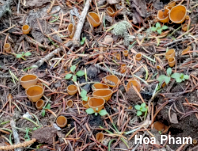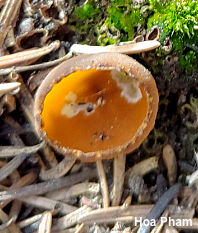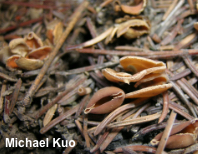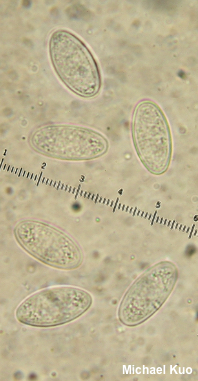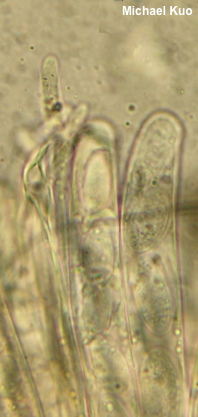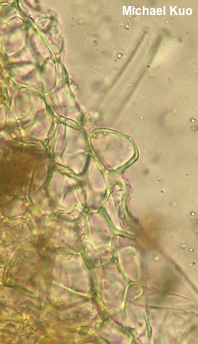| Major Groups > Cup Fungi > Geopyxis carbonaria |

|
Geopyxis carbonaria [ Ascomycota > Pezizales > Pyronemataceae > Geopyxis . . . ] by Michael Kuo This little cup fungus appears in burned northern and montane conifer forests, sometimes in astounding numbers, in the year after the fire. Its tiny fruiting bodies are goblet-shaped, complete with a tiny stem, and the surfaces are brownish orange. The margin of the cup is cream colored and irregularly toothed. In western North America, Geopyxis carbonaria is often found in the vicinity of burn-site morels, including Morchella tomentosa. While there are several similar species of Geopyxis, the only other species appearing on burned substrates is Geopyxis delectans, easily separated because it lacks a stem and is brighter orange; additionally its undersurface features tiny brown warts and its spores have more rounded ends. Geopyxis vulcanalis is a synonym. Thanks to Hoa Pham for collecting, documenting, and preserving Geopyxis carbonaria for study; her collection is deposited in The Herbarium of Michael Kuo. Description: Ecology: Saprobic and facultatively biotrophic (Vrålstad et al. 1998, Wang et al. 2016); growing gregariously or in loose clusters in burned conifer forests, beginning the year after the burn; spring through fall; originally described from Upper Lusatia (in present-day Germany and Poland) and widely distributed in Europe; fairly widely distributed in northern and montane North America; also known from the West Coast; recorded in Asia. The illustrated and described collection is from Colorado. Fruiting Body: 6–20 mm across; 4–20 mm high; shaped more or less like a goblet, with a cup-shaped portion sitting atop a narrow stem. Upper/Inner Surface: Brownish orange; bald. Margin: Clearly defined; creamy; finely and irregularly toothed Under/Outer Surface: Brownish orange; bald. Stem: 2–4 mm high; 1–3 mm wide; flaring at apex; colored like the outer surface; bald. Odor: Not distinctive. Microscopic Features: Spores 18–22 x 9–11 µm; subfusiform; smooth; hyaline in KOH. Asci 175–200 x 8–10 µm; cylindric; hyaline in KOH; tips not bluing in Melzer's; 8-spored. Paraphyses 180–210 x 2–3.5 µm; filiform; apices rounded or subacute; smooth; hyaline, or with scattered golden granules, in KOH. Excipular surface of irregularly subglobose elements 10–20 µm across; walls yellowish to hyaline in KOH. REFERENCES: Harkness, 1885. (Albertini & Schweinitz, 1805) Saccardo, 1889. (Fries, 1822; Kupfer, 1902; Breitenbach & Kränzlin, 1984; Schalkwijk-Barendsen, 1991; Lincoff, 1992; Vrålstad et al., 1998; McNeil, 2006; Perry et al., 2007; Laursen & Seppelt, 2009; Trudell & Ammirati, 2009; Tedersoo et al., 2010; Uzun et al., 2010; Buczacki et al., 2013; Beug, Bessette & Bessette, 2014; Desjardin, Wood & Stevens, 2015; Wang et al., 2016; Gminder & Böhning, 2017; Læssøe & Petersen, 2019.) Herb. Kuo 06302001. Herb. F C0335469F (NAMA 2010-222). This website contains no information about the edibility or toxicity of mushrooms. |
© MushroomExpert.Com |
|
Cite this page as: Kuo, M. (2020, December). Geopyxis carbonaria. Retrieved from the MushroomExpert.Com Web site: http://www.mushroomexpert.com/geopyxis_carbonaria.html. |
